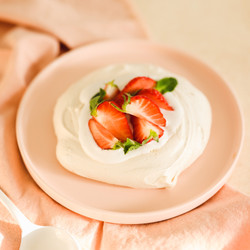Add the aquafaba to a small pot over low heat and cook, stirring occasionally, until the volume reduces to half. You'll want to end up with ¼ cup of reduced aquafaba.
Chill the reduced aquafaba by placing in an ice bath. It should be cool to the touch before you start working with it.
Add the reduced aquafaba, cream of tartar and xanthan gum to a stand mixer. Whip on high speed for about 5-8 minutes, making sure to pause and scrape down any edges as needed. The mixture will firm up quite a lot thanks to the xanthan gum.
Slowly start to add the sugar, 2 tablespoons at a time, waiting 30 seconds in between each addition. Again, take breaks to scrape down the sides of the mixing bowl as needed. Once all the sugar has been incorporated, continue to whip for another 5 minutes then add in the vanilla bean paste.
When the mixture is ready, it should be almost marshmallow-like in texture and you can test it by flipping the bowl over (it shouldn't fall out of the bowl at all).
Preheat the oven to 250F.
Divide your mixture into three parts and transfer to a lined baking sheet, leaving 2-3 inches around all edges of the pavlovas. Use a spatula to make circular discs and then make a little well in the center for toppings later on.
Bake the pavlovas for 2 hours and 15 minutes, making sure not to open the oven (even if you're tempted to check on them, don't!!!). After the 2 hours and 15 minutes passes, keep the door closed and turn the heat off completely. Let the pavlovas cool in the closed oven for another 1 hour and 30 minutes.
Once the pavlovas are cooked and cooled, top with vegan whipped cream of choice, to taste, and any fruit like sliced strawberries, mangoes etc. Only top just as you're about to serve, otherwise the pavlovas will absorb the moisture and lose their crisp exterior.
